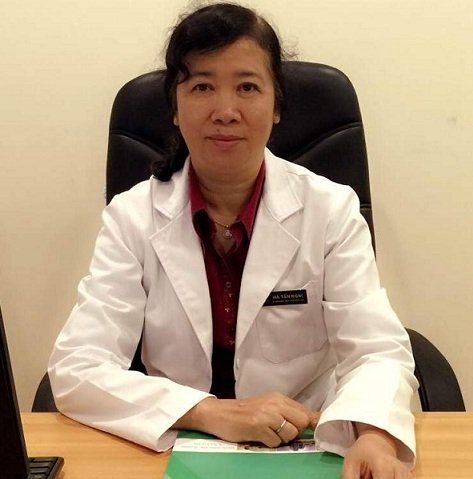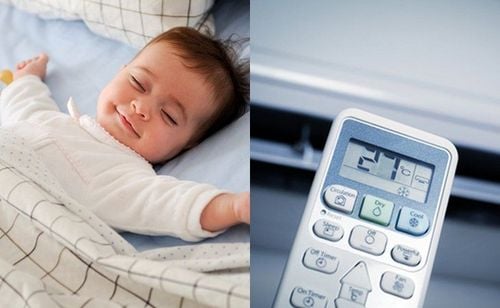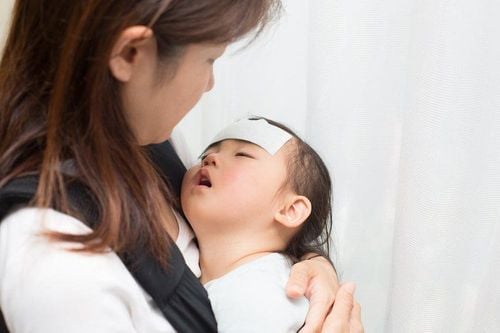This is an automatically translated article.
The article was professionally consulted by Specialist Doctor II Cao Thi Thanh - Pediatrician - Department of Pediatrics - Neonatology - Vinmec Hai Phong International General Hospital. Dr. Thanh has worked for 25 years in the treatment of neonatal pediatric diseases.Newborn fever can be one of the scary symptoms for parents, especially when the infant's temperature is high or the infant has a high fever when they are only a few weeks old. Here are the signs of a fever in babies and a safe temperature range.
1. Signs of fever in babies
A baby with a fever may behave differently, for example, being more irritable and fussy than usual. In addition, symptoms of fever in infants include:Poor sleep Poor eating and drinking Loss of interest in play Less activity or even coma Convulsions or seizures Fever can also lead to dehydration if the infant refuses to drink, has a poor appetite, or vomits. Young children can become dehydrated quickly when symptoms include:
Crying without tears Dry mouth Less wet diapers You can still wait to see if the fever goes away on its own if your baby doesn't seem to be having any problems. bear, sleep, eat or play normally.
2. Conditions associated with infants with fever
2.1. High/low temperature If your baby is under 3 months and has a rectal temperature of 100.4°F (38°C) or higher, call the doctor.Newborns have difficulty regulating their own body temperature when sick. This means your baby can get cold instead of hot. If the infant has a temperature lower than 97°F (36°C), parents should also call the doctor.

In many cases, a febrile convulsion will occur within the first few hours of the high fever, usually lasting just a few seconds and less than a minute. The baby may stiffen, twitch, and roll his eyes before becoming limp and unresponsive. Some babies' skin may look darker than usual.
This phenomenon often causes great concern to parents, but in reality, febrile seizures rarely lead to long-term damage. However, it is important to report these seizures to your doctor.
If the baby seems to be having trouble breathing or the seizure continues for more than five minutes, call 911 immediately.
2.3. Heatstroke/heatstroke In rare cases, a fever can be confused with a heat-related condition called heatstroke. If your baby is in a place that's too hot, or if he's dressed too tightly in hot and humid weather, heatstroke is possible. The cause of this condition is not an infection or abnormal problems inside the muscle.
Instead, heatstroke is a consequence of ambient heat levels. A child's temperature can rise to dangerously high levels - above 105°F (40.5°C), requiring rapid cooling.
Methods of cooling your baby include:
Wipe your baby's body with cool water Turn on a fan or hand fan Move your baby to a cooler place Heatstroke is considered an emergency, so immediately After cooling down, the baby must be taken to the doctor.
3. How to measure a newborn's temperature
You can take your baby's temperature in a number of different ways, such as through the rectum (anus), mouth, ears, under the arms (armpits), or at the temples. The American Academy of Pediatrics (AAP) recommends only using digital thermometers in children. Mercury thermometers should not be used to avoid the risk of mercury exposure and poisoning if broken.Placing a thermometer in the rectum will provide the most accurate measurement of the infant's temperature and is also easy to do in young children.
To take a rectal temperature, make sure the thermometer is clean first. Wash with soap and water or wipe with alcohol. Place the baby on his or her stomach or back, legs bent toward the chest. Apply a little vaseline around the thermometer bulb and gently insert it into the rectal opening. Hold the digital thermometer in place for about 2 minutes until you hear a beep. Then gently remove the thermometer and read the temperature.
A normal baby's temperature can range from about 97 - 100.3°F (36.1 - 37.9°C). Most doctors consider a rectal temperature of 100.4°F (38°C) or higher to be a fever.

4. When to call the doctor?
As recommended, call the doctor if your baby:Under 3 months old and has a fever. In particular, a baby under 2 months of age with a fever is considered an emergency. Seek immediate medical attention Coma or unresponsive breathing or feeding problems (Hards of breath, difficulty breathing, eating ice cream...) Very irritable, fussy, or restless Have a rash Have signs of dehydration, such as urinating less (less wet diapers), dry mouth, no tears when crying, or a soft, sunken spot on the head Having a seizure Doctors can have a hard time distinguishing differentiate infants from simple viral infections (such as a cold) from more serious infections (such as UTIs, pneumonia, or meningitis). That's why sometimes doctors will order some special tests (such as blood or urine tests, X-rays of the lungs, or scans of the spine) to pinpoint the exact cause. fever in infants.
Newborns with a high fever can worry and frighten parents, but it's important to remember that this simple fever is not usually a serious problem. So keep a close eye on your baby and get the right antipyretic treatment to ensure your baby's comfort. If you feel uncertain about your child's temperature or behavior, don't hesitate to consult your doctor.
When a child shows abnormal signs of health, parents can take the child to Vinmec Health system for timely examination and treatment.
As a key area of Vinmec Health System, Pediatrics Department - Vinmec International General Hospital always brings satisfaction to customers and is highly appreciated by industry experts thanks to the following advantages:
gathers a team of leading doctors and doctors in Pediatrics: including leading experts, with high professional qualifications (professors, associate professors, doctorates, masters), experienced, having worked in different hospitals. big hospitals like Bach Mai, 108.. The doctors are all well-trained, professional, have a heart - reach, understand young psychology. In addition to domestic pediatric specialists, the Department of Pediatrics also has the participation of foreign experts (Japan, Singapore, Australia, USA) who are always pioneers in applying the latest and most effective treatment regimens. . Comprehensive services: In the field of Pediatrics, Vinmec provides a series of continuous medical examination and treatment services from Newborn to Pediatric and Vaccine,... according to international standards to help parents take care of their baby's health from birth to childhood. from birth to adulthood Specialized techniques: Vinmec has successfully deployed many specialized techniques to make the treatment of difficult diseases in Pediatrics more effective: neurosurgery - skull surgery, stem cell transplantation. blood in cancer treatment. Professional care: In addition to understanding children's psychology, Vinmec also pays special attention to the children's play space, helping them to have fun and get used to the hospital's environment, cooperate in treatment, improve the efficiency of medical treatment.
Please dial HOTLINE for more information or register for an appointment HERE. Download MyVinmec app to make appointments faster and to manage your bookings easily.
Reference source: webmd.com; healthline.com; msdmanuals.com; healthdirect.gov.au













